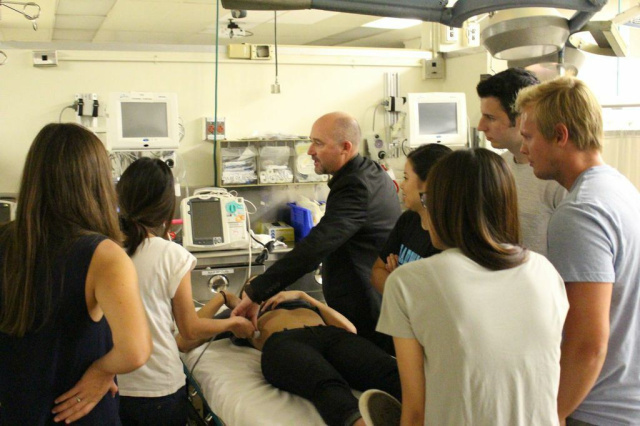
The Magic of Ultrasound at C-Booth (LA County/University of South California) By Chanel Fischetti, MS4 University of California Irvine School of Medicine What happens when you combine Sonosite ultrasound technology, C booth, and enthusiastic medical students? You find the inspiration for an enhanced medical education. On August 13th, more than 50 medical students voluntarily attended the first ultrasound student elective hosted in the infamous C booth, now a simulation centre for students and residents. The course opened with a guest lecture by Dr. Chris Fox to help set the stage for ultrasound education with the basics of how to operate ultrasound machines and what to look for when scanning different organ systems.  As more and more medical schools are integrating ultrasound into their medical education curriculum, it appears that now is the perfect time to expand these programmes with hands-on opportunities, such as Ultrasound Electives or Ultrafests. We can only hope that this enthusiasm to learn ultrasound will make these future physicians more fluent in this technology thereby giving them a major head start as residents in a variety of specialties.
As more and more medical schools are integrating ultrasound into their medical education curriculum, it appears that now is the perfect time to expand these programmes with hands-on opportunities, such as Ultrasound Electives or Ultrafests. We can only hope that this enthusiasm to learn ultrasound will make these future physicians more fluent in this technology thereby giving them a major head start as residents in a variety of specialties. 
 Then the students were divided into several different small groups where they had hands-on instruction in the eFAST, basic cardiology imaging, and anatomical positioning - volunteering their own bodies to serve as models for the practise sessions. They were even able to practise on a virtual ultrasound system, SonoSim, to get a glimpse into cardiac imaging and pathology. The hands-on faculty instructors for the event included Dr. Mikaela Chilstrom and Dr. Kristin Berona, ultrasound fellow Dr. Amin Abdi, resident Dr. Danny Choi, sonographer Jeannine Childs, and several 4th year medical student volunteers. The event was overwhelmingly well-received and feedback was extremely positive. Students remarked that the “dynamic faculty/instructors” led to an “amazing hands-on experience”. While this is only the first in what University Southern California hopes to be a series of elective encounters, one thing is for sure - the students are hungry to learn this technology and visual diagnostic tool.
Then the students were divided into several different small groups where they had hands-on instruction in the eFAST, basic cardiology imaging, and anatomical positioning - volunteering their own bodies to serve as models for the practise sessions. They were even able to practise on a virtual ultrasound system, SonoSim, to get a glimpse into cardiac imaging and pathology. The hands-on faculty instructors for the event included Dr. Mikaela Chilstrom and Dr. Kristin Berona, ultrasound fellow Dr. Amin Abdi, resident Dr. Danny Choi, sonographer Jeannine Childs, and several 4th year medical student volunteers. The event was overwhelmingly well-received and feedback was extremely positive. Students remarked that the “dynamic faculty/instructors” led to an “amazing hands-on experience”. While this is only the first in what University Southern California hopes to be a series of elective encounters, one thing is for sure - the students are hungry to learn this technology and visual diagnostic tool.  As more and more medical schools are integrating ultrasound into their medical education curriculum, it appears that now is the perfect time to expand these programmes with hands-on opportunities, such as Ultrasound Electives or Ultrafests. We can only hope that this enthusiasm to learn ultrasound will make these future physicians more fluent in this technology thereby giving them a major head start as residents in a variety of specialties.
As more and more medical schools are integrating ultrasound into their medical education curriculum, it appears that now is the perfect time to expand these programmes with hands-on opportunities, such as Ultrasound Electives or Ultrafests. We can only hope that this enthusiasm to learn ultrasound will make these future physicians more fluent in this technology thereby giving them a major head start as residents in a variety of specialties.

